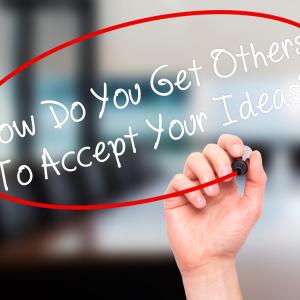Influencing other people to change their minds can be challenging. We all resist having our opinions adjusted by others, especially when the message is opposed to our currently held beliefs.
But what if you could influence others by allowing them to persuade themselves? We pay attention to ourselves easily. Having the person you seek to influence generate arguments for your cause will have personal relevance for them.
It’s not as difficult as it sounds. Actually people are being encouraged to influence themselves all the time. Here are a few examples:
- As parents, we ask our child why they think something might be wrong rather than just giving them a blind command.
- At times we are asked to be in a role-playing exercise or a debate format, we might espouse attitudes and values in which we don’t currently believe.
- When we want to change a habit, say, to healthier eating or exercising, we might try to convince ourselves we don’t like the forbidden foods as much as we do or that the exercise won’t be as difficult as it appears.
There are a myriad of life situations in which we are argue with ourselves seeking change, whether it’s because it’s self-initiated or because someone else has placed us in such a situation.
We’ve all seen the TV sketch where an underling states a solution in a meeting only to have the boss restate it exactly and say, “Now THAT is a great idea I just came up with.” It’s used as a comedy line all the time but it turns out it is remarkably true. We like our own ideas best.
Self-Influence
But does it truly work? Does self-influence make any real difference?
Janis and King (1954) tested the theory of self-persuasion by having participants give a talk while two other subjects listened. Then they swapped positions and one of the passive listeners gave a talk to the other two subjects on a different topic.
The study revealed that the people were more convinced to change positions by the talk they gave themselves than when they merely listened to it passively. This research reveals that we are persuaded more strongly when we make an argument ourselves, even if it isn’t in line with our own current viewpoint.
A similar study was done in regards to smoking. People are more apt to stop smoking when they were asked to deliver an anti-smoking message themselves rather than passively receiving it (Brinol et al., 2012).
The explanation for this results is that we are very good at convincing ourselves because we know just what sort of obstacles we have and which arguments will sway us.
Devil’s Advocate
If you perceive you might receive opposition to a particular decision, action or attitude you need adopted, here is a strategy to consider. Ask those whom you seek to influence to create and present the arguments FOR the end decision you want to achieve. Tell them you want them to play the role of the affirmative party in a dialog or debate on the subject. Ask them to list their objections and then create a countering argument for each.
Here are some questions they should consider:
- Envision each step and process from beginning to end. How will the idea work?
- Why is this new action or decision necessary?
- What are the consequences if take this new action?
- What is the worst that could happen?
- What is the best thing that can happen?
- If this turned out to be a dream solution, paint the picture of what this looks like.
- Do we have the resources to accomplish this?
- If not, how can we gain the resources needed or accomplish this with 50% less resources?.
Why is this technique so strong in ushering in change?
As humans, we are not only in need of convincing by logical means, by in need of full persuading by logical, psychological and emotional. This is true influence. By involving the person in his or her own shift of opinion, there is emotional buy-in present. The process of assembling of the argument actually forges a deep shift within the individual whereby they start firmly believing their arguments since they are self-generated.
If receivers have the motivation, ability and opportunity to process information, they will follow the central route in processing the information, elaborating rationally on such direct benefit-based claims of the change of mind position. Once this elaboration starts, psychologists propose that a deep intellectual event takes place in which the validity of the solution and the elaborations of that solution become deeply engrained. These self-generated ideas are truly the best in our own eyes. Working to further elaborate a solution allows us to convince ourselves that the idea is truly our own, and in many senses it actually becomes that as we improve on and add details to the original solution.
The Elaboration Likelihood Model (ELM), developed in 1986 by Richard E. Petty and John Cacioppo, is based on the idea that any one variable can influence attitudes in a number of different ways and can serve to either increase or decrease persuasion through several different mechanisms (Petty et al., 2002).
ELM assumes that there are two routes of persuasive influence: central and peripheral. The key factor in selecting the routes in ELM is involvement; how much a person thinks and invests in a subject in order to form an opinion. When a person is actively thinking and internally processing the content of a subject, elaboration is high and will most likely follow the central persuasive route. However, when a person is not interested in a subject elaboration is low, which will result in information processed through the peripheral route.
This model proposes that when people are motivated to process information and are cognitively able to engage in the subject, they make decisions through the central route. This type of decision making results in a permanent attitude shift and the person will begin to elaborate on the arguments presented, further strengthening the argument. When the person is not actively processing the information, the person is subject to making decisions based on periphery issues—like or dislike of speaker, music in commercials. Petty et al. note that a person’s motivation to engage in a subject is not static. For example, a person who suffers from lung cancer may be more motivated to actively consume information on smoking cessation programs. The same person may not be as interested in consuming information about gardening and will therefore process the information on a peripheral level. (source)
Start Today
So create the role playing/devil’s advocate/debate position scenarios, and with a small bit of guidance you’ll watch some of the chief objectors becoming some of your best proponents and supporters. Consider starting the scenario hypothetically so the participants don’t feel like they are conflicting with their own current viewpoint. Allow them ample time to process and create their arguments so you get their best work, and thus, their best self-influence.
Soon, you will begin seeing dramatic shifts in the depth at which you can get others to change their minds.
So if you want someone to persuade themselves, you can try asking them to put aside their own attitude for a moment and try getting them to generate their own arguments for the point you want to make.
Whatever the cover story, as long as the person is encouraged to generate their own arguments, it has a chance of changing their mind.





